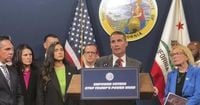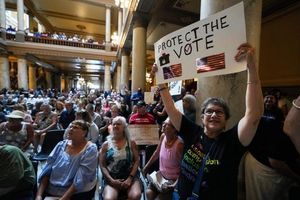California politics is rarely dull, but the latest battle brewing in Sacramento may be one for the history books. On August 18, 2025, Democratic lawmakers returned to the Capitol with a singular, urgent mission: to redraw the state’s congressional districts in a move that could dramatically reshape the U.S. House of Representatives. At the heart of this effort is a plan, spearheaded by Governor Gavin Newsom, to offset a Republican redistricting push in Texas that threatens to tip the balance of power in Congress ahead of the 2026 midterm elections.
According to reporting from the Associated Press, the new congressional map, unveiled just last week, could net California Democrats five additional U.S. House seats in 2026. That’s no small feat in a state where Democrats already control 43 of 52 seats. The proposal is a direct response to President Donald Trump’s campaign to redraw Texas’ congressional lines, a move that could flip five Democratic seats to Republican control and help preserve the GOP’s slim House majority.
But pulling off this political counterpunch is anything but straightforward. California’s process for drawing congressional districts has, since 2010, been in the hands of an independent citizen commission—a system voters chose to remove partisan influence from the equation. Newsom’s plan would temporarily override the commission’s authority, allowing a Democratic-drawn map to take effect until after the 2030 Census. Crucially, this change can only happen with voter approval in a statewide special election set for November 4, 2025.
“Donald Trump, you have poked the bear and we will punch back,” Newsom declared at a rally last week, formally launching the campaign. “Don’t mess with the great Golden State.” The governor’s words reflect the heightened partisan tension, as both parties gear up for a national showdown over congressional control. As reported by CalMatters, the Election Rigging Response Act—the official name of Newsom’s ballot measure—frames the redistricting push as a necessary response to what Democrats call a Trump-induced political emergency.
The urgency is palpable. California’s primary election is scheduled for June, with candidate filing deadlines fast approaching in early March. If the new map is to be in place in time for candidates to know which voters they’ll need to court, lawmakers must act quickly. The secretary of state’s office has warned that the Legislature must finalize the plan by August 22 to meet ballot mailing deadlines for the November special election. That leaves lawmakers with just days to hold hearings, debate the proposal, and pass the necessary legislation.
On Monday, more than 30 Democratic lawmakers stood alongside California Representatives Zoe Lofgren and Pete Aguilar to introduce their legislative package. “If Trump moves forward, California will be the firewall,” state Senator Sebrina Cervantes said, capturing the defiant mood among Democrats. The plan is to hold hearings and then vote to put the new map before voters this fall. If approved, the map would replace the current commission-drawn districts, which took effect in 2022, and remain in use through the 2030 elections—unless Texas or another Republican-led state backs off its own mid-decade redistricting.
But the path ahead is far from clear. State Republicans have vowed to challenge the effort in court, arguing that voters already made their wishes known in 2010 when they stripped lawmakers of the power to draw their own districts. “Citizens, not politicians or partisan party insiders, should not only hold the power at the ballot box but also the power to draw the lines,” Amy Thoma Tan, spokesperson for the campaign to defend the commission, said in a statement to CalMatters. The National Republican Congressional Committee echoed that sentiment, promising to "fight Gavin Newsom’s illegal power grab in the courts and at the ballot box."
Public opinion on the issue is mixed. A Politico poll found that nearly two-thirds of California voters prefer to keep the independent redistricting commission in charge, wary of a return to the days of partisan gerrymandering. However, internal polling shared with Democratic lawmakers suggests that support for Newsom’s measure rises to 52% when the plan is presented as a response to Republican efforts in Texas. Whether that’s enough to secure victory in November remains to be seen, especially with the prospect of a high-spending, high-stakes campaign on both sides.
And then there’s the matter of cost. The last statewide special election in California—the failed recall of Newsom in 2021—ran up a tab of about $200 million. Newsom has argued that consolidating the special election with municipal votes on November 4 will save money, but early estimates from counties are already raising eyebrows: up to $4 million in Fresno and as much as $16 million in Riverside, according to CalMatters. “No price tag for democracy,” Newsom told reporters last week, brushing aside concerns about the expense.
The California redistricting saga is unfolding against a backdrop of similar partisan battles across the country. As reported by the Associated Press, Republicans in Texas, who currently hold 25 of 38 congressional seats, are looking to increase their tally to 30 through a new map pushed by Trump and GOP leaders. Texas Democrats tried to stall the process with a two-week walkout, but relented only after California Democrats signaled their own willingness to redraw the map in the Golden State. Other Republican-controlled states, including Florida, Indiana, and Missouri, are also considering mid-decade redistricting to cement their advantages.
California’s situation is unique, however. The state’s independent redistricting commission was created in 2008 after years of partisan gridlock and accusations of gerrymandering. Democrats now find themselves in the awkward position of seeking to temporarily override a system they once championed—albeit with a promise to return map-making powers to the commission after the next census. Democratic leaders insist that the new map will honor the Voting Rights Act and adhere to the commission’s strict criteria, even as it tilts the playing field in their favor.
The stakes could hardly be higher. With Republicans holding just a seven-seat majority in the 435-member House, the addition or subtraction of a handful of seats in California or Texas could determine which party controls Congress for the final two years of Trump’s term. As the Associated Press notes, the 2026 midterms are shaping up as a crucial test for both parties, with redistricting at the center of the fight.
While the redistricting debate dominates headlines, California lawmakers are also grappling with a slew of other pressing issues in the final month of the legislative session. Bills related to immigration enforcement, climate change, wildfire response, and racial justice are all on the docket, underscoring the breadth of challenges facing the state.
Whether California’s bold gambit pays off—or backfires—will soon be in the hands of the voters. With deadlines looming and political passions running high, the next few months promise to be a defining chapter in the state’s political history.





